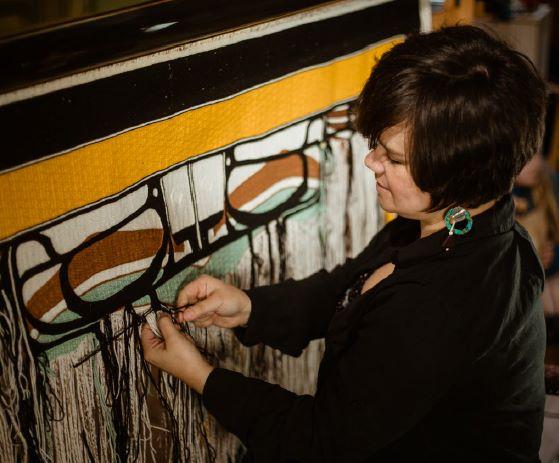Winter 2023-24, FORUM Magazine
MOST PEOPLE DON'T QUITE KNOW what to expect when they walk into the new Wooshinkindein Da.aat Lily Hope Weaver Studio. Wooshkindein Da.aat, Lily’s Tlingit name, means “walking together one behind another.” Located in downtown Juneau, the studio is in the perfect location to catch the eye of the wandering visitor. Window displays of woven jewelry, weaving kits, and photos of Chilkat blankets pique one’s curiosity. Renowned Chilkat weaver Lily Hope beckons to the hesitators, encouraging any patron to come and learn about this once endangered artform. Before they know it, they are drawn into the beauty of Chilkat as they handle a tuft of mountain goat wool and watch Lily skillfully fingertwine the yarns into a story of spirit and community.
Lily, Tlingit, Raven T’aḵdeintaan, was born in 1980 in Juneau to full-time artist parents. Her father, Bill Hudson, is a painter and multimedia artist. Her mother, the late Clarissa Rizal, was a multimedia artist and Chilkat weaver who studied alongside master Chilkat weaver, Jennie Thlunaut. Lily grew up in Juneau and remembers watching her mother’s hands constantly at work while she was encouraged to help. She would help lay out mother-of-pearl buttons, stir the dye pot, or wind yarns, and thigh-spin warp. Given her parentage, it’s no surprise that Lily was destined to become one of the most renowned Chilkat weavers of her generation, but if you ask her, she will clarify that she didn’t always recognize herself as a weaver.
Chilkat is a woven art form practiced by Tlingit, Haida, Tsimshian, and other Northwest Coast peoples of the US and Canada. The Chilkat ceremonial robes are commissioned by clan leaders or given as gifts to be danced during cultural ceremonies and are coveted by museums and fine art collectors. Historically, the robes were twined on a warp of thigh-spun mountain goat wool and cedar bark, but in the present day, Merino wool is used as it is easier to obtain. The Merino weft yarns can be dyed with natural materials like hemlock and wolf moss. A full-size ceremonial blanket is time- and labor-intensive. It can take up to 2,500 hours of labor, not only due to the finger-twining and braiding of the pattern, but also because a weaver will invest several hundred hours in material prep or purchasing prepared materials (which can cost upwards of $7,000) before they even begin warping up the loom. The designs come from the Northwest Coast art style, Formline, and are adapted to work within the twining techniques. The designs record history that calls on ancestors when the robe is danced, the fringe swaying out from the wearer to the witnesses in threads of connection. It’s a magical experience that Lily likens to “watching a child take their first steps.”

